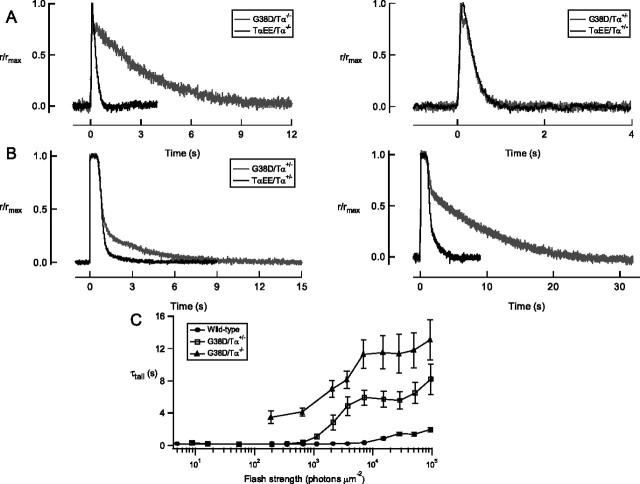Figure 6.
A, Dim flash responses recover slowly in G38D/Tα−/− rods but not in G38D/Tα+/− rods. Left, G38D/Tα−/− rods were much slower to recover to dim flashes of light than TαEE/Tα−/− rods. Right, G38D/Tα+/− and TαEE/Tα+/− rods recovered along similar time courses. Dim flash responses from seven rods were averaged and normalized by the peak amplitude of the average dim flash response, which were (in picoamperes) 0.9 (G38D/Tα−/−), 1.7 (TαEE/Tα−/−), 1.5 (G38D/Tα+/−), and 1.8 (TαEE/Tα+/−). The average flash strength for each group (in photons μm−2) was 255 (G38D/Tα−/−), 10.2 (TαEE/Tα−/−), 12.5 (G38D/Tα+/−), and 7.3 (TαEE/Tα+/−). B, G38D/Tα+/− rods recovered more slowly than control rods in response to bright flashes. Representative saturating flash responses from G38D/Tα+/− (gray) and TαEE/Tα+/− (black) rods matched for both time in saturation and dominant time constant of recovery. From left to right, the flash strengths (in photons μm−2) used to elicit the responses were 2161 and 7322 (G38D/Tα+/−) and 2048 and 6940 (TαEE/Tα+/−). Note the slow “tail” of recovery of the G38D/Tα+/− responses. The maximal responses for these two cells were 13.1 pA (G38D/Tα+/−) and 12.3 pA (TαEE/Tα+/−) C, The final falling phase of recovery from wild-type, G38D/Tα+/−, and G38D/Tα−/− responses was fitted with a single exponential (τtail). At dim flash strengths, recovery of responses from G38D/Tα+/− rods was indistinguishable from that of wild-type rods. As the flash strength increased, the τtail increased until, at the brightest flash strengths, it was very similar to G38D/Tα−/− rods.

